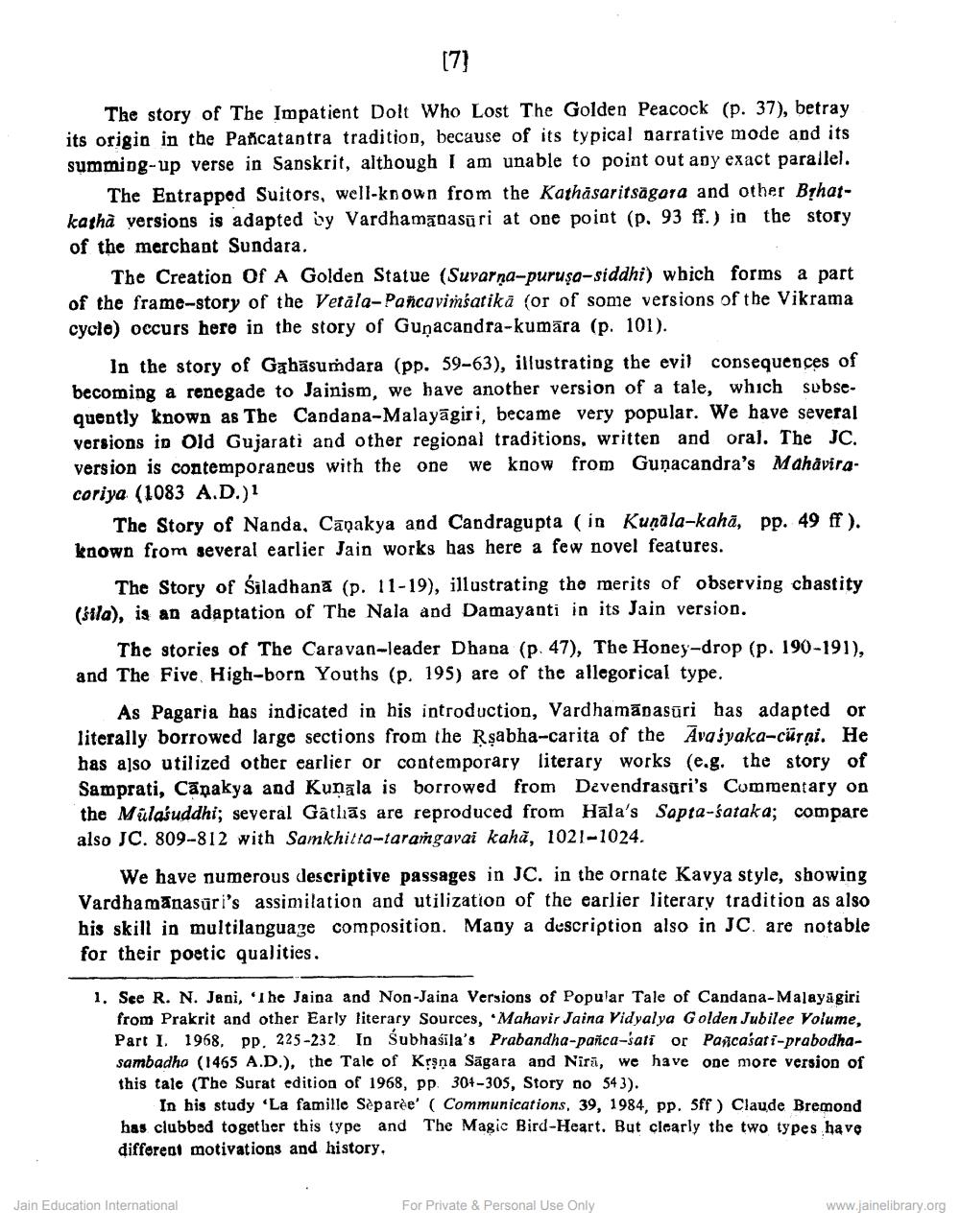Book Title: Jugaijinandachariyam Author(s): Vardhmansuri, Rupendrakumar Pagariya, Dalsukh Malvania, Nagin J Shah Publisher: L D Indology Ahmedabad View full book textPage 8
________________ (7) The story of The Impatient Dolt Who Lost The Golden Peacock (p. 37), betray its origin in the Pancatantra tradition, because of its typical narrative mode and its summing-up verse in Sanskrit, although I am unable to point out any exact parallel. The Entrapped Suitors, well-known from the Kathasaritsagora and other Bịhatkaphà versions is adapted by Vardhamībasūri at one point (p. 93 ff.) in the story of the merchant Sundara. The Creation Of A Golden Statue (Suvarna-puruşa-siddhi) which forms a part of the frame-story of the Vetäla-Pañcavimšatikā (or of some versions of the Vikrama cycle) occurs here in the story of Guņacandra-kumāra (p. 101). In the story of Gabāsuņdara (pp. 59-63), illustrating the evil consequences of becoming a renegade to Jainism, we have another version of a tale, which subsequently known as The Candana-Malayāgiri, became very popular. We have several versions in Old Gujarati and other regional traditions, written and oral. The JC. version is contemporaneus with the one we know from Gunacandra's Mahaviracoriya (1083 A.D.)1 The Story of Nanda, Caņakya and Candragupta (in Kunala-kahā, pp. 49 ff). known from several earlier Jain works has here a few novel features. The Story of siladhana (p. 11-19), illustrating the merits of observing chastity (bila), is an adaptation of The Nala and Damayanti in its Jain version. The stories of The Caravan-leader Dhana (p. 47), The Honey-drop (p. 190-191), and The Five High-born Youths (p. 195) are of the allegorical type. As Pagaria has indicated in his introduction, Vardhamāpasūri has adapted or literally borrowed large sections from the Rşabha-carita of the Avaiyaka-cürņi. He has also utilized other earlier or contemporary literary works (e.g. the story of Samprati, Cāņakya and Kunala is borrowed from Devendrasuri's Commentary on the Mülasuddhi; several Gâtlıās are reproduced from Hala's Sapta-śataka; compare also JC. 809-812 with Samkhitta-taramgavai kahă, 1021-1024. We have numerous descriptive passages in JC. in the ornate Kavya style, showing Vardhamanasūri's assimilation and utilization of the earlier literary tradition as also his skill in multilanguage composition. Many a description also in JC. are notable for their poetic qualities. 1. See R. N. Jani, 'The Jaina and Non-Jaina Versions of Popular Tale of Candana-Malayagiri from Prakrit and other Early literary Sources, .Mahavir Jaina Vidyalya Golden Jubilee Volume, Part I. 1968. Pp. 225-232 In Subhasila's Prabandha-pañca-sati or Pancasati-prabodhasambadho (1465 A.D.), the Tale of Krna Sāgara and Nirā, we have one more version of this tale (The Surat edition of 1968, pp. 301-305, Story no 543). In his study 'La famille Separèe' (Communications, 39, 1984, pp. 5ff) Claude Bremond has clubbed together this type and The Magic Bird-Heart. But clearly the two types have different motivations and history, Jain Education International For Private & Personal Use Only www.jainelibrary.orgPage Navigation
1 ... 6 7 8 9 10 11 12 13 14 15 16 17 18 19 20 21 22 23 24 25 26 27 28 29 30 31 32 33 34 35 36 37 38 39 40 41 42 43 44 45 46 47 48 49 50 51 52 53 54 55 56 57 58 59 60 61 62 63 64 65 66 67 68 69 70 71 72 73 74 75 76 77 78 79 80 81 82 ... 322
